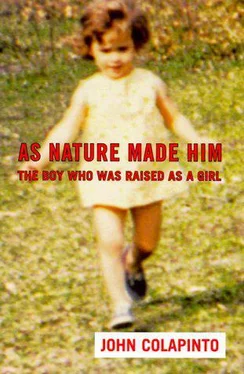Reveling in his role as “agent provocateur of the sexual revolution” (as the New York Times dubbed him in 1975), Money rarely missed an opportunity to spread his gospel of sexual emancipation: extolling the heightened pleasures of sex under a black light to a student after a speaking engagement at the University of Nebraska; appearing in court as an expert witness to defend the 1973 pornographic film Deep Throat , which he praised as a “cleansing” movie that would help keep marriages together; penning op-ed pieces for the New York Times in which he called for a “new ethic of recreational sex.” A patient treated by Money in the 1970s for a rare endocrine disorder recalls the psychologist once casually asking him if he’d ever experienced a “golden shower.” A sexually inexperienced youth at the time, the patient did not know what Money was talking about. “Getting pissed on,” Money airily announced with the twinkling, slightly insinuating smile with which he liked to deliver such deliberately provocative comments.
Convinced that embargoes on certain words promoted prudery, Money inserted the words fuck , cock , and cunt into his regular conversation with colleagues and patients. Dr. Fred Berlin, a professor of psychiatry at the Johns Hopkins School of Medicine and a colleague who considers Money one of his most important mentors, defends Money’s penchant for sexual outspokenness. “Because he thinks it’s important to desensitize people in discussing sexual issues,” Berlin says, “he will sometimes use four-letter words that others might find offensive. Perhaps he could be a little more willing to compromise on that, but John is an opinionated person who isn’t looking necessarily to do things differently than the way he’s concluded is best.”
While Money’s conclusions about the best approach to sexual matters merely raised eyebrows in the mid-1970s, they provoked outrage at the dawn of the more conservative 1980s, when Money ventured into areas of which even some of the most adventurous sexual explorers were leery. In 1986, Money published Lovemaps , an exhaustive study of such practices as sadomasochism, coprophilia, amputation fetishes, autostrangulation, and various other behaviors that he called, not perversions, but “paraphilias,” in an effort to destigmatize and decriminalize them. The topic of pedophilia became a particular interest, and one that Money took obvious delight in publicly espousing.
“A childhood sexual experience,” he explained to Time magazine in April 1980, “such as being the partner of a relative or of an older person, need not necessarily affect the child adversely.” He granted an interview to Paidika , a Dutch journal of pedophilia, which carries ads for the North American Man-Boy Love Association and other pro-pedophile groups. “If I were to see the case of a boy aged ten or twelve who’s intensely attracted toward a man in his twenties or thirties, and the relationship is totally mutual, and the bonding is genuinely totally mutual, then I would not call it pathological in any way,” he told the journal, and added, “It’s very important once a relationship has been established on such positive and affectionate grounds that it should not be broken up precipitously.” In 1987, Money wrote an admiring foreword to an unusual volume published in Denmark entitled Boys and Their Contacts with Men . By Dutch professor Theo Sandfort, the book presented what purported to be verbatim testimonials of boys as young as eleven years old rhapsodically describing the delights of sex with men as old as sixty. “For those born and educated after the year 2000,” Money wrote, “we will be their history, and they will be mystified by our self-important, moralistic ignorance of the principles of sexual and erotic development in childhood.” Money concluded his foreword with the proclamation “It is a very important book, and a very positive one.”
Money’s response to criticism for the public airing of such views was always to launch counterattacks of his own, ridiculing his critics for their adherence to an outmoded sexual Puritanism. In an autobiographical essay included in his 1985 book of collected writings, Venuses Penuses , Money dubbed himself a “missionary” of sex, proudly proclaiming, “It has not been as easy for society to change as it had been for me to find my own emancipation from the 20th-century legacy of fundamentalism and Victorianism in rural New Zealand.”
Money’s experimental, taboo-breaking attitude to sex found its echo in the way he pursued his professional research career. Eschewing the more trammeled byways of sex research, Money deliberately sought out exotic corners of the field. He found just such a relatively undiscovered realm of human sexuality in 1948, while in the first year of study for his Ph.D. in psychology at Harvard. In a tutorial called Fieldwork and Seminar in Clinical Psychology, Money was presented with the case of a fifteen-year-old genetic male born not with a penis, but with a tiny, nublike phallus resembling a clitoris. At puberty, the boy had developed breasts. It was Money’s first exposure to hermaphroditism—also known as intersexuality—a term of classification for a variety of birth anomalies of the internal and external sex organs. Often described in lay terms as a condition of being half-man, half-woman, the syndrome derives its name from a combination of the names of the Greek gods of love, Hermes and Aphrodite, and occurs as often as one in two thousand births (by some estimates). The symptoms vary from the extreme manifestation of a genetic female born with a penis-sized clitoris and fused labia resembling a scrotum, to a male whose genital resemblance to a girl at birth is so total that his true biological sex is not suspected until puberty when “she” fails to menstruate—to anything in between.
Money was fascinated by hermaphroditism and wrote his doctoral dissertation on the subject. Until then the syndrome had been studied almost solely from a biological perspective. Money approached it from a psychological angle, investigating the mental and emotional repercussions of growing up as anatomically neither boy nor girl. His thesis, entitled “Hermaphroditism: An Inquiry into the Nature of a Human Paradox,” was completed in 1952 and led to his invitation to join Johns Hopkins, where the world’s first and largest clinic for studying and treating intersexual conditions had been established. The clinic’s director, pioneering pediatric endocrinologist Lawson Wilkins, teamed Money with two married psychiatrists, Drs. Joan and John Hampson, to study the mental and emotional makeup of the intersexual patients treated in the clinic. The three researchers made up the newly created Psychohormonal Research Unit.
Over the next six years, Money and the Hampsons studied some 131 intersexuals ranging in age from toddlers to adults. Money (who was lead investigator and author of the team’s published reports) claimed to observe a striking fact about intersexes who had been diagnosed with identical genital ambiguities and chromosomal makeups but raised in the opposite sex from one another: more than 95 percent of them reportedly fared equally well psychologically whether they had been raised as boys or girls. Money called these groupings of patients “matched pairs” and said they were proof that the primary factor determining an intersexual child’s gender identity was not biology, but rather the way the child was raised. He concluded that these children were born wholly undifferentiated in terms of their psychological sex and that they formed a conception of themselves as masculine or feminine solely through rearing.
This theory was the foundation on which Money based his recommendation to Johns Hopkins surgeons and endocrinologists that they could surgically and hormonally steer intersexual newborns into whichever sex, boy or girl, they wished. Such surgeries would range from cutting down enlarged clitorises on mildly intersexual girls to full sex reversal on intersexual boys born with undeveloped penises. These conversions to girlhood were foreordained by the state of surgical technology: it was easier for surgeons to construct a synthetic vagina than to create an artificial penis. Money’s only provisos were that such “sex assignments” and reassignments be done within the first two and a half years of life (after which time, Money theorized, a child’s psychosexual orientation ceased to be as malleable) and that once the sex had been decided upon, doctors and parents never waver in their decision lest they risk introducing fatal ambiguities into the child’s mind.
Читать дальше












